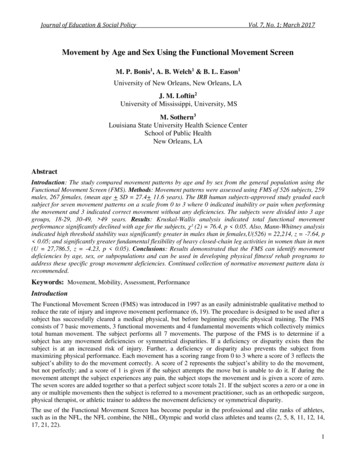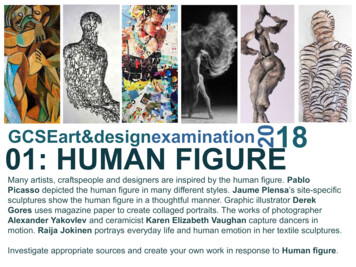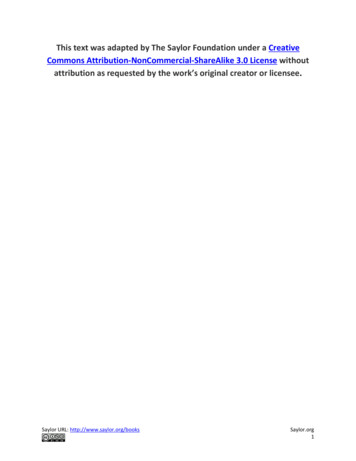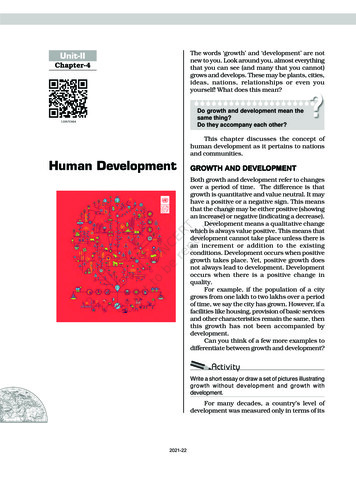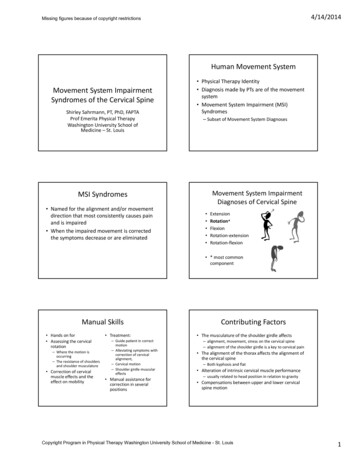
Transcription
4/14/2014Missing figures because of copyright restrictionsHuman Movement SystemMovement System ImpairmentSyndromes of the Cervical SpineShirley Sahrmann, PT, PhD, FAPTAProf Emerita Physical TherapyWashington University School ofMedicine – St. Louis Physical Therapy Identity Diagnosis made by PTs are of the movementsystem Movement System Impairment (MSI)Syndromes– Subset of Movement System DiagnosesMovement System ImpairmentDiagnoses of Cervical SpineMSI Syndromes Named for the alignment and/or movementdirection that most consistently causes painand is impaired When the impaired movement is correctedthe symptoms decrease or are eliminated ion‐flexion * most commoncomponentManual Skills Hands on for Assessing the cervicalrotation– Where the motion isoccurring– The resistance of shouldersand shoulder musculature Correction of cervicalmuscle effects and theeffect on mobility Treatment:– Guide patient in correctmotion– Alleviating symptoms withcorrection of cervicalalignment,– Cervical motion– Shoulder girdle musculareffects Manual assistance forcorrection in severalpositionsContributing Factors The musculature of the shoulder girdle affects– alignment, movement, stress on the cervical spine– alignment of the shoulder girdle is a key to cervical pain The alignment of the thorax affects the alignment ofthe cervical spine– Both kyphosis and flat Alteration of intrinsic cervical muscle performance– usually related to head position in relation to gravity Compensations between upper and lower cervicalspine motionCopyright Program in Physical Therapy Washington University School of Medicine - St. Louis1
4/14/2014Missing figures because of copyright restrictionsCommon ImpairmentsUpper Cervical Range of Motion Intrinsic neck muscles become weak or long ‐compromise fine control of vertebral motion Extrinsic muscles become dominant adding tocompressive, rotational, & shear forcesexerted on the cervical spineHead and Neck ExtensorsLower Cervical Range of Motion Intrinsic musclessemispinalis capitissemispinalis cervicispure sagittal rotationDeRosa & PorterfieldAttachment of Cervicoscapular MusclesExtension with TranslationHead & Neck Rotators/extensors Trapezius ‐Levator Scapulae Intrinsic muscles semispinalis cervicis superior obliqueinferior oblique rectus capitiscervicisAttached to C2DeRosa & PorterfieldCopyright Program in Physical Therapy Washington University School of Medicine - St. LouisDeRosa & Porterfield2
4/14/2014Missing figures because of copyright restrictionsMovements of the Upper ExtremitiesCervical motion induced by shoulder motionSigns and Contributing Factors: Altered upper and lower cervicalparticipation; over developed extensors, inadequate deep neckflexorsCERVICAL EXTENSION SYNDROMECervical extension with shoulder flexion.Shoulder Flexion while contracting deep neck flexorsDecreases cervical extension and painSigns and Contributing Factors: Asymmetrical upper and lower cervicalrotation; Imprecise rotation; Altered action of Cervico‐scapular musclesCERVICAL ROTATION SYNDROMEUpward rotation of scapula stretches levator scapulae musclecervical vertebrae will rotate to same side if hypermobileUpper trapezius rotates head & neck to opposite sideKendall 1993Copyright Program in Physical Therapy Washington University School of Medicine - St. LouisKendall 19933
4/14/2014Missing figures because of copyright restrictionsCervical rotation to the right during left shoulder flexionTennis instructorRight shoulderflexionLeft shoulderflexionSpinousprocessesto leftAsymmetrical RotationCervical rotation limited bytrapezius and levator scapulae musclesMaximum rotationShoulders passively elevatedUpper and lower shifted to leftCervical rotation limited byupper trapezius & levator scapulae musclesMaximum rotationCervical Rotation: Impaired ‐Affected by Cervico‐Scapular MusclesRotation with shoulders elevatedUpper cervical rotation not lowerCopyright Program in Physical Therapy Washington University School of Medicine - St. Louis4
4/14/2014Missing figures because of copyright restrictionsImpaired FlexionNeck Flexors Intrinsic muscles Longus capitis Longus colli Pure sagittalrotationForward head with increaseupper thoracic flexionDeRosa & PorterfieldFlexion – lower spine remainsextendedDominant ExtrinsicNeck FlexorsSternocleidomastoidMultiple Actions Sternocleidomastoid Sternal & clavicular head Mastoid significant influence on cervical spine motion butdoes not directly attach to CspineExtend upperC‐spineRotation Function: bilateral ‐ flexionunilateral ‐ rotate to oneside & laterally flex toopposite sideFlexionlower C‐spineMechanical Neck Pain - Porterfield & DeRosaLengthen IntrinsicNeck FlexorsForwardtranslation withanterior shearParticularly withweak intrinsicsMechanical Neck Pain - Porterfield & DeRosaDeep Neck Flexor Muscle Weakness Longus capitis TP’s C3‐6 Occiput Longus colli TP’s C3‐C5 C1 archBodies of T1,2,3 TP’s C5,6Bodies of C5‐7, T1‐3 Bodiesof C2,3,4Mechanical Neck Pain Porterfield & DeRosaCopyright Program in Physical Therapy Washington University School of Medicine - St. Louis5
4/14/2014Missing figures because of copyright restrictionsWeak Deep Neck Flexor MusclesUnable to Maintain FlexionImpaired Positioning – CervicalExtension with RockingUpper Cervical ExtensionShoulder Elevation and KyphosisContributing to Cervical ExtensionInitial visitUpper cervical extension greater thanLower cervical -Limited cervical flexionImproved Alignment – Decreased PainInitial visit2 weeks later2 weeks laterContributing factors: long trunk, short arms,large breasts with bras straps adding to downwardpull on neckPoor sitting alignmentCopyright Program in Physical Therapy Washington University School of Medicine - St. LouisCorrected sitting alignment6
4/14/2014Missing figures because of copyright restrictionsDominant ExtrinsicNeck FlexorsScaleni:Anterior ‐ TP’sC3‐6 1st ribMiddle ‐ TP’sC2‐7 1st ribPosterior ‐ TP’sC5‐7 1st ribFunction:Flexion with anterior shearSigns and Contributing Factors: Flat cervical and thoracic spineCERVICAL FLEXION SYNDROMEDepressed chest affectscervical alignmentMechanical Neck Pain - Porterfield & DeRosaCervical Flexion and Flat ThoracicSpineCervical Lordosis with thoracic kyphosisKendall 1993Impaired CorrectionKendall 1993Another form of Flexion Syndrome: SwaybackSCALENE MUSCLE RESTRICTIONCopyright Program in Physical Therapy Washington University School of Medicine - St. Louis7
4/14/2014Missing figures because of copyright restrictionsWithout arm supportWith arm supportPassive elevation of rib cageShoulder Depression – CervicalCompressionInitial VisitTwo Months laterCervical surgery twice still in constant painShoulder Depression – CervicalExtensionImproved Shoulder Motion –Decreased CompressionInitial VisitInitial VisitTwo Months LaterCopyright Program in Physical Therapy Washington University School of Medicine - St. LouisTwo Months Later8
Prof Emerita Physical Therapy Washington University School of Medicine –St. Louis Human Movement System Physical Therapy Identity Diagnosis made by PTs are of the movement system Movement System Impairment (MSI) Synd

